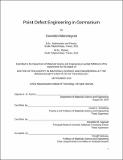Point defect engineering in germanium
Author(s)
Monmeyran, Corentin
DownloadFull printable version (6.877Mb)
Alternative title
Point defect engineering in Ge
Other Contributors
Massachusetts Institute of Technology. Department of Materials Science and Engineering.
Advisor
Lionel C. Kimerling and Anuradha M. Agarwal.
Terms of use
Metadata
Show full item recordAbstract
In 1947, the first transistor was made of germanium, but soon silicon became the core material of computer chips because of its processability. However, as the typical dimensions of transistors are getting closer to the atomic size, the traditional approach of scaling down transistors to improve performance is reaching its limits, and other elements need to be used in conjunction with silicon. Germanium is one of the key materials to empower silicon based devices because it possesses electronic and optoelectronic properties complementary to those of silicon, among them higher carrier mobilities and a direct band gap (G-valley) at 1.55 [mu]m (the telecom C-band, therefore adding new capabilities to silicon integrated microphotonics). Furthermore, good quality Ge layers can be grown epitaxially on a Si substrate, allowing a monolithic integration of devices. However, compared to silicon, little is known about the point defects in germanium. The goal of the present doctoral work is to remedy this gap. To this end, we have used radiation (gamma rays, alpha particles, and neutrons) to controllably introduce point defects in crystalline germanium, which were then characterized by Deep-Level Transient Spectroscopy (DLTS), a technique that allows the determination of the activation energy, capture cross-section, and concentration of the said defects. By studying their electronic properties, annealing kinetics, and introduction rates, we were able to separate vacancy-containing from interstitial-containing defects and gain insight on their physical nature and formation process. We especially identified a di-interstitial defect and a tri-interstitial defect. In addition, we proved that in the case of alpha particles and neutron irradiation, the fact that defects are generated in a collision cascade influences their carrier capture rates and annealing behaviors. We have also characterized the impact of radiation on commercial germanium-on-silicon photodetectors, and showed that point defects associate with dislocations in epitaxial Ge-on-Si layers. Finally, we have investigated the passivation of midgap states by implanting germanium with fluorine, and showed how the interaction between the halogen element, the amorphous/crystalline interface during the solid phase epitaxy, and the implantation damage is key in obtaining a high performance material
Description
Thesis: Ph. D., Massachusetts Institute of Technology, Department of Materials Science and Engineering, 2016. This electronic version was submitted by the student author. The certified thesis is available in the Institute Archives and Special Collections. Cataloged from student-submitted PDF version of thesis. Includes bibliographical references (pages 121-127).
Date issued
2016Department
Massachusetts Institute of Technology. Department of Materials Science and EngineeringPublisher
Massachusetts Institute of Technology
Keywords
Materials Science and Engineering.